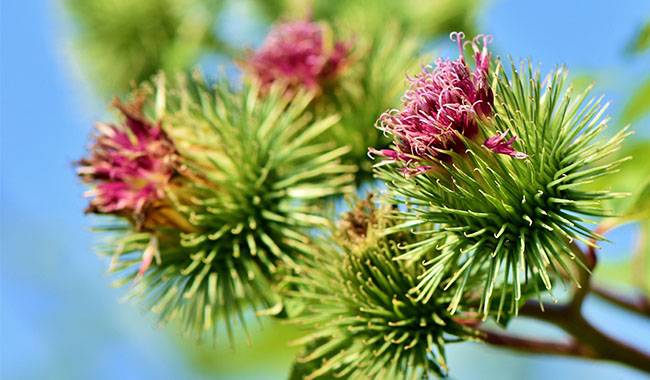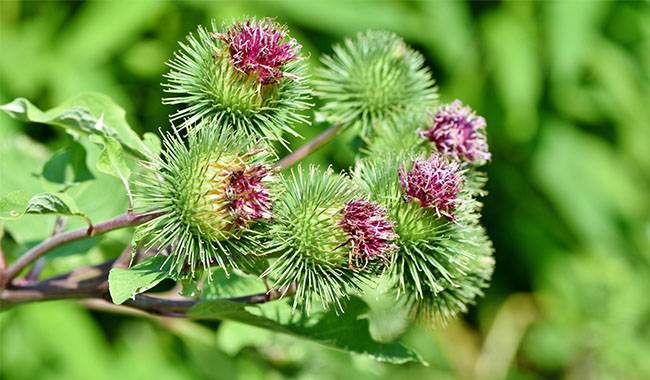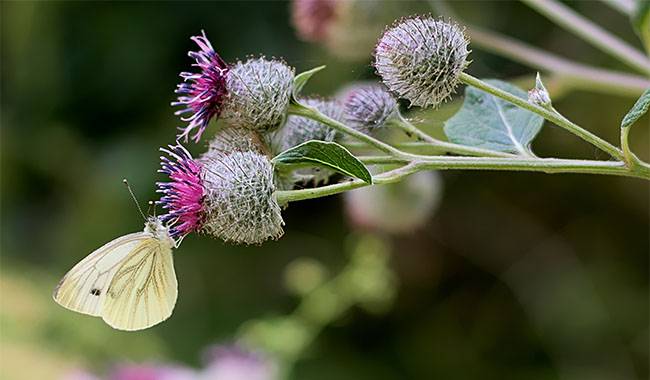
Many people have a contemptuous attitude towards this wonderful plant. Many call Burdock a dull-headed… Burdock’s cones were violently plucked from their clothing… They were mercilessly removed from the site as weeds… In this ThumbGarden article, I’ll discuss Burdock’s unique medicinal properties, as well as its culinary and cosmetic uses. Perhaps your perception of this amazing rather than harmful plant will change radically. You will learn Burdock – the value of Cooking, beauty and medicinal in the ThumbGarden article.
What Are the Medicinal Uses of Burdock?
Plants of the genus Palmaria (Arctium) are herbaceous, with a branched stem and large, firm leaves. The seed heads have hooked inclusions that attach to animal hairs and can spread over long distances. burdock is primarily a biennial weed that flowers in its second year. The genus includes about 20 species, but only a few of them are medicinal plants.
Burdock, or Repei. a large biennial plant. In its first year of life, develops a rosette of large, petiolate, ovate leaves with gray spikes on the back. The roots are succulent and supplied with nutrients. In the second year of life, a branched, web-like, hairy stem reaches a height of 40 inches (1 m). The stems are erect and have deep whiskers.
The distinctive bulbous baskets are assembled as shields, supported by a roof-like net-like wrap of two rows of leaflets: the outer leaflets are green with curved needles downward, the inner ones are purple and have no hooks. The hooks of the baskets easily stick to animal hair and people’s outer clothing. The flowers are oviposited and have purple corollas. Underneath are anthers with peculiar pendants. The fruit is an achenes with a short, flying bulb. The plant blooms in summer. It is widely distributed in Europe and Western Asia as well as the United States.
The roots of young Burdock plants are harvested for medicinal purposes. They contain tannins, vitamins, fatty acids, mucilage and the polysaccharide inulin. They have diuretic, laxative and diuretic properties, are used to treat eczema, and promote hair growth. the roots of Burdock are also used in medicine.
Large Burdock (Arctium lappa, or Arctium majus). It is a biennial weedy herbaceous plant. It is a so-called handicap (litter) plant that is ubiquitous near human settlements.
The roots, seeds and even the leaves of Burdock are used for medicinal purposes. the roots of Burdock are thick and succulent and contain inulin, tannins and bitterness. The leaves are large, heart-shaped ovate, with solid margins or emarginate teeth, and spider-webbed teeth alternately arranged on the back. The leaves contain vitamin C, carotenoids and traces of alkaloids. The stems are branched and can grow up to 60 inches (1.5 m) tall.
In its first year of life, Burdock grows a bunch of leaves and forms a stem in the second year. Leaves on first-year plants can reach 20 inches (50 cm) in size, with petioles up to 12 inches (30 cm) long. The flower baskets are arranged in a corymbose pattern, the wrapped leaves are glabrous or slightly webbed with sharp hooks, and the corolla is purplish-red tubular. The plant blooms in August-September.
Burdock minor (Arctium minus) has a branched stem that varies in height from 24-48 inches (60-120 cm). The baskets are fuchsia and all the flowers are tubular. The leaves have a spider-web wrapper with hooks at the ends. A weedy biennial plant that blooms in June-July. Very common in parts of Europe.
Burdock in Folk Medicine

Burdock roots are harvested in the fall or early spring (before the leaves appear). The roots of the first year can be used for medicinal purposes. The roots of the second year are fibrous and coarse, so they are not suitable for medicinal use.
Roots that have been dug up should not be washed; they should be dried, brushed, and then cut lengthwise and dried in an oven or dryer. If dried naturally at room temperature, the roots may ferment. Properly dried Burdock roots are suitable for medicinal use for three to five years.
Burdock is a diuretic and diaphoretic. In folk medicine, a decoction of Burdock root is used to treat diseases of the genitourinary system. For diabetes, Burdock root is used in equal proportions with pods and blueberry leaves.
It is also used in the treatment of rheumatism, rickets and hemorrhoids. In the treatment of rheumatism, Burdock root is recommended to be used in combination with eleuthero root (1:1). In addition, in rheumatism and metabolic disorders (eczema), a decoction of the root is used externally in the form of a warm compress.
Decoctions of the root are also used in folk medicine to treat other metabolic disorders. For example, gallstone and urolithiasis, salt deposits in joints, various skin diseases (acne, seborrheic dermatitis, nutritional ulcers), chronic constipation, gastritis, cough, stomach ulcers, for removal of tapeworms.
Burdock seed decoction is recommended for the treatment of chronic constipation. The flowers are used to treat allergic diseases. a decoction of Burdock leaves can be applied topically to treat eczema and septic wounds. Fresh Burdock leaf juice is used to treat wounds. An ointment made by finely chopping and boiling the roots and young leaves of Burdock is used to treat burns.
- A decoction of the root can be applied externally for the treatment of pruritus.
- A decoction of Burdock’s root is used to wash the hair twice a week for the treatment of hair loss.
- The fresh leaves of Burdock and mother’s womb are used as a dressing for mastitis.
Leaves boiled with milk are used to treat wounds, boils, furuncles, and gouty inflammation. The fresh leaves are applied to rheumatism, radiculitis and boils on sore spots. They are also good for headaches.
Fresh and dried leaves are used in therapeutic baths. the fresh juice of Burdock leaves is used to remove warts. They are coated with sour cream and applied to rusty warts. The fresh leaf pulp is used to treat nutritional ulcers. In strong sunlight, Burdock leaves can protect your head.
Tip: All the medicinal properties of Burdock described in this article are for information purposes only. Self-medication is not allowed. Medical advice is required. Contraindications to the use of Burdock – pregnancy, lactation and allergies.
Burdock in Cosmetology
Root extracts from olive or almond oil (Burdock oil) can be used to strengthen the hair roots. Oil packs and various hair masks with Burdock oil added are very effective. They improve hair growth and can also be used to remove dandruff. For blonde hair, chamomile can be added to the preparation of Burdock oil, and to improve growth, a few drops of pepper extract can be added.Burdock oil can also be used to improve the growth of eyelashes and to soften and moisturize body skin.
It can be prepared at home with Burdock. Pour 75 grams of crushed Burdock leaves into a cup of olive oil and steep for 24 hours. Then boil, strain through a gauze cloth and squeeze. Use as an oil pack.
Pour 300 grams of crushed fresh roots into 500 ml of olive oil or almond oil. Soak in a dark place for 14 days and then strain.
You can also wash your hair with Burdock root decoction every other day to treat hair loss or dandruff. Aqueous decoction of the following ingredients is very effective Add 20 grams of Burdock root, 10 grams of calendula and 15 grams of hops cones per 0.26 gals (1 liter) of water.
Burdock leaf juice or crushed fresh leaves can be used to treat pustules on the face. burdock extract is often used in the industrial production of facial creams, hair products, lip balms and sunscreens.
Using Burdock in Cooking
Cooked Burdock roots can be fried as a garnish and sometimes Burdock roots can be basted. They can also be pickled and used as a very special accompaniment to meat dishes. The dried roots can be ground into flour and used to make pancakes. They can also be made into porridge.
In Japan and China, Burdock is grown in beds as a cultivated plant. Burdock roots are decorative in the United States, but also in Belgium and France.
A. Spring Vitamin Burdock Salad
Wash 50 grams of fresh leaves, blanch them in boiling water, chop them, add 50 grams of green onions, salt to taste, and season with sour cream. If desired, grated horseradish can be added. In addition, the tender leaves of Burdock combine well with a salad of boiled meat and eggs. Cucumbers or tomatoes can also be added.
B. Burdock Soup
You can use Burdock leaves to make soup. Cook 200 g of potatoes and 40 g of washed rice in broth 0.13 gals (0.5 l). 10 minutes before preparation, add shredded Burdock leaves in the amount of 300 gals and onion (1 medium sized onion) sautéed in oil. Season with salt and pepper to taste. Add herbs and sour cream, if desired.
C. Burdock jelly
Place 500 g of chopped Burdock root in acidulated water and cook until thickened. Add 50 ml of acetic or citric acid. You can also use yogurt, sour cherries or sour plums.
You can make a combination jam. Add 1.1 lbs (0.5 kg) of red currants, gooseberries or sour apples to 2.2 lbs (1 kg) of Burdock root. This jam tastes good and is not harmful to diabetes.
D. Burdock – a coffee substitute
Peeled and washed Burdock roots are crushed, dried, and roasted in the oven until brown. Grind in a coffee grinder and brew 1-2 teaspoons per 1 cup of boiling water. It can be mixed with chicory in equal amounts. This coffee substitute is useful for diabetes.
Burdock in Veterinary Medicine

Burdock is most commonly used in veterinary medicine for its diuretic and diaphoretic properties. It is used to treat kidney and bladder stones, gastritis, gastric ulcers and duodenal ulcers. Burdock root is prescribed in the ground at 15-40 grams for horses and cattle, pigs – 5-10 grams, and dogs 0.2-2 grams per day.
The root of Burdock is also used in the form of decoction and ointment for the treatment of animals. To make the ointment, 75 grams of freshly cut Burdock roots are taken per 200 ml of olive oil, held in a warm place for one day, then boiled and filtered.
The fresh leaves have antiseptic properties and can be applied to abscess wounds and used to treat dermatitis. Fresh Burdock juice and leaves are used to treat furuncles, pharyngitis and as a wound healing agent. burdock preparations are low in toxicity and have no side effects.
Protection of Plants with Burdock
An infusion of green Burdock leaves can be used to repel chard moths and moths of the crucifer family. For the infusion, you will need one-third of a bucket of fresh green Burdock leaves. It should be filled to the top of the bucket with warm water and waited for three days. The infusion should then be filtered. Spray the plants with this infusion once a week during the moth’s summer season. This is usually done 3-4 times per season.
The same infusion also helps to control fruit moths, sawworms and aphids. Fruit trees are sprayed 3-4 times between June and July at 1 week intervals. Many times, Burdock leaves are pounded into the ground to protect the seedlings from the hot sun.



